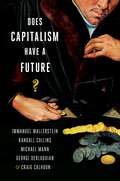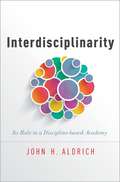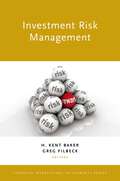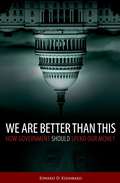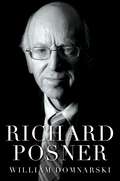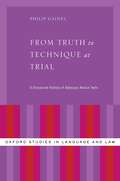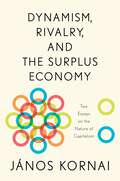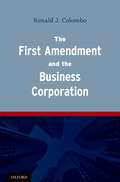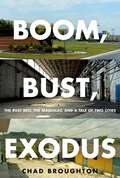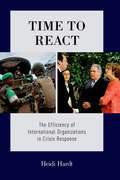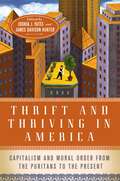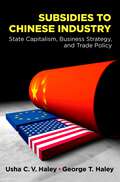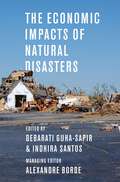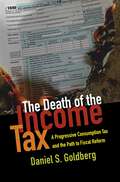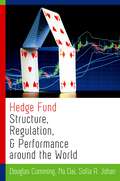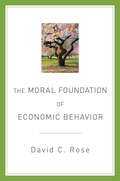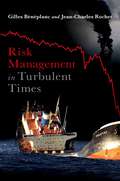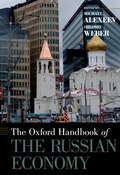- Table View
- List View
Does Capitalism Have a Future?
by Randall Collins Michael Mann Craig Calhoun Immanuel Wallerstein Georgi DerluguianIn Does Capitalism Have a Future?, a global quintet of distinguished scholars cut their way through to the question of whether our capitalist system can survive in the medium run. Despite the current gloom, conventional wisdom still assumes that there is no real alternative to capitalism. The authors argue that this generalization is a mistaken outgrowth of the optimistic nineteenth-century claim that human history ascends through stages to an enlightened equilibrium of liberal capitalism. All major historical systems have broken down in the end, and in the modern epoch several cataclysmic events-notably the French revolution, World War I, and the collapse of the Soviet bloc-came to pass when contemporary political elites failed to calculate the consequences of the processes they presumed to govern. At present, none of our governing elites and very few intellectuals can fathom a systemic collapse in the coming decades. While the book's contributors arrive at different conclusions, they are in constant dialogue with one another, and they construct a relatively seamless-if open-ended-whole. Written by five of world's most respected scholars of global historical trends, this ambitious book asks the most important of questions: are we on the cusp of a radical world historical shift?
Interdisciplinarity: Its Role in a Discipline-based Academy
At the turn of the twentieth century, colleges and universities in the U.S. and elsewhere were convulsed with change, a change induced by the creation of the modern set of academic disciplines. Their emergence at that time fundamentally altered how universities were constructed and how they did their business. It is the model on which the academy of the twenty-first century operates. Very shortly after the creation of the disciplinary-based academy, pressures began to build, both in the academy and in the society that looked to the academy to help solve pressing social problems, to develop interdisciplinary approaches to address problems that fit poorly within the disciplinary structure. These external and internal forces never fully abated, and peaked after the Second World War. They have peaked again more recently, and the contemporary college and university is therefore a rich amalgam of disciplinary and interdisciplinary units, problems, approaches, and structures. Interdisciplinarity examines the contemporary academy by connecting its disciplinary-based structure with its burgeoning interdisciplinary focus. Part I looks at the value of the disciplinary structure in the contemporary university alongside the motivations that lead to calls for greater interdisciplinary approaches. Part 2 traces the development of external forces, particularly the private and public foundation, that shaped the development of interdisciplinary scholarship in the twentieth century. The final two sections examine in detail interdisciplinary education and the organization of university-based interdisciplinary research.
Investment Risk Management (Financial Markets and Investments)
All investments carry with them some degree of risk. In the financial world, individuals, professional money managers, financial institutions, and many others encounter and must deal with risk. Risk management is a process of determining what risks exist in an investment and then handling those risks in the best-suited way. This is important because it can reduce or augment risk depending on the goals of investors and portfolio managers. The main purpose of Investment Risk Management is to provide an overview of developments in risk management and a synthesis of research involving these developments. The book examines ways to alter exposures through measuring and managing those exposures and provides an understanding of the latest strategies and trends within risk management. The scope of the coverage is broad and encompasses the most important aspects of investment risk management. Its 30 chapters are organized into six sections: (1) foundations of risk management, (2) types of risk, (3) quantitative assessment of risk, (4) risk and risk classes, (5) hedging risk and (6) going forward. The book should be of particular interest to sophisticated practitioners, investors, academics, and graduate finance students. Investment Risk Management provides a fresh look at this intriguing but complex subject.
We Are Better Than This: How Government Should Spend Our Money
by Edward D. KleinbardWe Are Better Than This fundamentally reframes budget debates in the United States. Author Edward D. Kleinbard explains how the public's preoccupation with tax policy alone has obscured any understanding of government's ability to complement the private sector through investment and insurance programs that enhance the general welfare and prosperity of our society at large. He argues that when we choose how government should spend and tax, we open a window into our "fiscal soul," because those choices are the means by which we express the values we cherish and the regard in which we hold our fellow citizens. Though these values are being diminished by short-sighted decisions to starve government, strategic government spending can directly make citizens happier, healthier, and even wealthier. Expertly combining the latest economic research with his insider knowledge of the budget process into a simple yet compelling narrative, he unmasks the tax mythologies and false arguments that too often dominate contemporary discourse about budget policies. Large quantities of comparative data are succinctly distilled to situate the United States among its peer countries, so that readers can judge for themselves whether contemporary budget choices really reflect our aspirational fiscal soul. Kleinbard's presentation takes a multi-disciplinary approach, drawing on economics, finance, law, political science and moral philosophy. He uniquely weaves economic research and moral philosophy together by emphasizing our welfare, not just our national income, and by contrasting the actual beliefs of Adam Smith, a great moral philosopher, with the cartoon version of the man presented by proponents of the most extreme forms of private market triumphalism.
We Are Better Than This: How Government Should Spend Our Money
by Edward D. KleinbardWe Are Better Than This fundamentally reframes budget debates in the United States. Author Edward D. Kleinbard explains how the public's preoccupation with tax policy alone has obscured any understanding of government's ability to complement the private sector through investment and insurance programs that enhance the general welfare and prosperity of our society at large. He argues that when we choose how government should spend and tax, we open a window into our "fiscal soul," because those choices are the means by which we express the values we cherish and the regard in which we hold our fellow citizens. Though these values are being diminished by short-sighted decisions to starve government, strategic government spending can directly make citizens happier, healthier, and even wealthier. Expertly combining the latest economic research with his insider knowledge of the budget process into a simple yet compelling narrative, he unmasks the tax mythologies and false arguments that too often dominate contemporary discourse about budget policies. Large quantities of comparative data are succinctly distilled to situate the United States among its peer countries, so that readers can judge for themselves whether contemporary budget choices really reflect our aspirational fiscal soul. Kleinbard's presentation takes a multi-disciplinary approach, drawing on economics, finance, law, political science and moral philosophy. He uniquely weaves economic research and moral philosophy together by emphasizing our welfare, not just our national income, and by contrasting the actual beliefs of Adam Smith, a great moral philosopher, with the cartoon version of the man presented by proponents of the most extreme forms of private market triumphalism.
Richard Posner
by William DomnarskiJudge Richard Posner is one of the great legal minds of our age, on par with such generation-defining judges as Holmes, Hand, and Friendly. A judge on the U.S. Court of Appeals for the Seventh Circuit and the principal exponent of the enormously influential law and economics movement, he writes provocative books as a public intellectual, receives frequent media attention, and has been at the center of some very high-profile legal spats. He is also a member of an increasingly rare breed-judges who write their own opinions rather than delegating the work to clerks-and therefore we have unusually direct access to the workings of his mind and judicial philosophy. Now, for the first time, this fascinating figure receives a full-length biographical treatment. In Richard Posner, William Domnarski examines the life experience, personality, academic career, jurisprudence, and professional relationships of his subject with depth and clarity. Domnarski has had access to Posner himself and to Posner's extensive archive at the University of Chicago. In addition, Domnarski was able to interview and correspond with more than two hundred people Posner has known, worked with, or gone to school with over the course of his career, from grade school to the present day. The list includes among others members of the Harvard Law Review, colleagues at the University of Chicago, former law clerks over Posner's more than thirty years on the United States Court of Appeals for the Seventh Circuit, and even other judges from that court. Richard Posner is a comprehensive and accessible account of a unique judge who, despite never having sat on the Supreme Court, has nevertheless dominated the way law is understood in contemporary America.
Richard Posner
by William DomnarskiJudge Richard Posner is one of the great legal minds of our age, on par with such generation-defining judges as Holmes, Hand, and Friendly. A judge on the U.S. Court of Appeals for the Seventh Circuit and the principal exponent of the enormously influential law and economics movement, he writes provocative books as a public intellectual, receives frequent media attention, and has been at the center of some very high-profile legal spats. He is also a member of an increasingly rare breed-judges who write their own opinions rather than delegating the work to clerks-and therefore we have unusually direct access to the workings of his mind and judicial philosophy. Now, for the first time, this fascinating figure receives a full-length biographical treatment. In Richard Posner, William Domnarski examines the life experience, personality, academic career, jurisprudence, and professional relationships of his subject with depth and clarity. Domnarski has had access to Posner himself and to Posner's extensive archive at the University of Chicago. In addition, Domnarski was able to interview and correspond with more than two hundred people Posner has known, worked with, or gone to school with over the course of his career, from grade school to the present day. The list includes among others members of the Harvard Law Review, colleagues at the University of Chicago, former law clerks over Posner's more than thirty years on the United States Court of Appeals for the Seventh Circuit, and even other judges from that court. Richard Posner is a comprehensive and accessible account of a unique judge who, despite never having sat on the Supreme Court, has nevertheless dominated the way law is understood in contemporary America.
From Truth to Technique at Trial: A Discursive History of Advocacy Advice Texts (Oxford Studies in Language and Law)
by Philip GainesFrom Truth to Technique addresses key questions raised by the burgeoning literature in what Philip Gaines calls advocacy advice texts-manuals, handbooks, and other how-to guides-written by lawyers for lawyers, both practicing and aspiring, to help them be as effective as possible in trial advocacy. In these texts, advice authors share principles, strategies, and techniques for persuading juries and winning cases. Some manuals even form the basis for required advocacy courses in law schools. Unlike training manuals in other professional domains-sales, leadership, management, fundraising, coaching, etc.-advocacy advice texts offer guidance for effectiveness in a realm of activity where the stakes may be the very highest for the parties and where society has an abiding interest in the truth being discovered and justice being done. Helping advocates learn how to win cases may be the ultimate purpose of advice texts, but to what extent are ideas about the values of truth and justice-what Gaines calls metavalues-incorporated into discussions about winning tactics and techniques? To explore this question, Gaines takes the reader through a discursive history of the relation between technique and metavalues as presented in advocacy advice-beginning with a thematic analysis of the first texts published in the Anglo-American tradition in the early 17th century, through treatises written during seasons of radical change in the profession in the 18th and 19th centuries, and up to the present day with a look at the more than 200 trial manuals currently in print. This diacronic study reveals dramatic changes in the place authors give to the metavalues of truth and justice when lawyers advise other lawyers about how to be effective in the courtroom.
Dynamism, Rivalry, and the Surplus Economy: Two Essays on the Nature of Capitalism
by János KornaiIn Dynamism, Rivalry, and the Surplus Economy, János Kornai examines capitalism as an economic system and in comparison to socialism. Kornai explains his view of capitalism as an economy of surplus--a chronic excess of supply of goods and labor. This environment breeds rivalry among producers, which in turn encourages innovation. Socialism, on the other hand, is defined by a shortage of goods and labor and excess of demand. Whereas socialism is slothful and imitative, capitalism is dynamic and progressive. The two essays of this book will explore these differing ideologies on macro and micro levels, ending with definitive explanations of how the systems work and how they develop.
Dynamism, Rivalry, and the Surplus Economy: Two Essays on the Nature of Capitalism
by János KornaiIn Dynamism, Rivalry, and the Surplus Economy, János Kornai examines capitalism as an economic system and in comparison to socialism. Kornai explains his view of capitalism as an economy of surplus--a chronic excess of supply of goods and labor. This environment breeds rivalry among producers, which in turn encourages innovation. Socialism, on the other hand, is defined by a shortage of goods and labor and excess of demand. Whereas socialism is slothful and imitative, capitalism is dynamic and progressive. The two essays of this book will explore these differing ideologies on macro and micro levels, ending with definitive explanations of how the systems work and how they develop.
The First Amendment and the Business Corporation
by Ronald J. ColomboThe role of the business corporation in modern society is a controversial one. Some fear and object to corporate power and influence over governments and culture. Others embrace the corporation as a counterweight to the State and as a vehicle to advance important private objectives. A flashpoint in this controversy has been the First Amendment to the U.S. Constitution, which enshrines the fundamental rights of freedom to speech, religion, and association. The extent to which a corporation can avail itself of these rights goes a long way in defining the corporation's role. Those who fear the corporation wish to see these rights restricted, while those who embrace it wish to see these rights recognized. The First Amendment and the Business Corporation explores the means by which the debate over the First Amendment rights of business corporations can be resolved. By recognizing that corporations possess constitutionally relevant differences, we discover a principled basis by which to afford some corporations the rights and protections of the First Amendment but not others. This is critically important, because a "one-size-fits-all" approach to corporate constitutional rights seriously threatens either democratic government or individual liberty. Recognizing rights where they should not be recognized unnecessarily augments the already considerable power and influence that corporations have in our society. However, denying rights where they are due undermines the liberty of human beings to create, patronize, work for, and invest in companies that share their most cherished values and beliefs.
Boom, Bust, Exodus: The Rust Belt, the Maquilas, and a Tale of Two Cities
by Chad BroughtonDonald Trump and Bernie Sanders owed much of their unexpected popularity in the 2016 primaries to their respective stances on trade and immigration policy. Political elites and policy experts were bewildered by combative talk of building a wall and the ubiquity of anti-TPP (Trans-Pacific Partnership) sloganeering in what many saw as a bizarre election cycle. They have scrambled to explain both Trump's victory and the new political fault lines that have emerged in both major political parties, largely around trade and immigration. In struggling industrial towns and cities, the rise of Trump and Sanders was less of a surprise. These places have long weathered globalization's storm. Many feel left behind and sold short. They are anxious, and they're demanding answers. Galesburg, Illinois, is one such city.
Boom, Bust, Exodus: The Rust Belt, the Maquilas, and a Tale of Two Cities
by Chad BroughtonDonald Trump and Bernie Sanders owed much of their unexpected popularity in the 2016 primaries to their respective stances on trade and immigration policy. Political elites and policy experts were bewildered by combative talk of building a wall and the ubiquity of anti-TPP (Trans-Pacific Partnership) sloganeering in what many saw as a bizarre election cycle. They have scrambled to explain both Trump's victory and the new political fault lines that have emerged in both major political parties, largely around trade and immigration. In struggling industrial towns and cities, the rise of Trump and Sanders was less of a surprise. These places have long weathered globalization's storm. Many feel left behind and sold short. They are anxious, and they're demanding answers. Galesburg, Illinois, is one such city.
Financial and Macroeconomic Connectedness: A Network Approach to Measurement and Monitoring
by Francis X. Diebold Kamil YilmazConnections among different assets, asset classes, portfolios, and the stocks of individual institutions are critical in examining financial markets. Interest in financial markets implies interest in underlying macroeconomic fundamentals. In Financial and Macroeconomic Connectedness, Frank Diebold and Kamil Yilmaz propose a simple framework for defining, measuring, and monitoring connectedness, which is central to finance and macroeconomics. These measures of connectedness are theoretically rigorous yet empirically relevant. The approach to connectedness proposed by the authors is intimately related to the familiar econometric notion of variance decomposition. The full set of variance decompositions from vector auto-regressions produces the core of the 'connectedness table.' The connectedness table makes clear how one can begin with the most disaggregated pair-wise directional connectedness measures and aggregate them in various ways to obtain total connectedness measures. The authors also show that variance decompositions define weighted, directed networks, so that these proposed connectedness measures are intimately related to key measures of connectedness used in the network literature. After describing their methods in the first part of the book, the authors proceed to characterize daily return and volatility connectedness across major asset (stock, bond, foreign exchange and commodity) markets as well as the financial institutions within the U.S. and across countries since late 1990s. These specific measures of volatility connectedness show that stock markets played a critical role in spreading the volatility shocks from the U.S. to other countries. Furthermore, while the return connectedness across stock markets increased gradually over time the volatility connectedness measures were subject to significant jumps during major crisis events. This book examines not only financial connectedness, but also real fundamental connectedness. In particular, the authors show that global business cycle connectedness is economically significant and time-varying, that the U.S. has disproportionately high connectedness to others, and that pairwise country connectedness is inversely related to bilateral trade surpluses.
FINANCIAL & MACROECONOMIC CONNECTED C: A Network Approach to Measurement and Monitoring
by Francis X. Diebold Kamil YilmazConnections among different assets, asset classes, portfolios, and the stocks of individual institutions are critical in examining financial markets. Interest in financial markets implies interest in underlying macroeconomic fundamentals. In Financial and Macroeconomic Connectedness, Frank Diebold and Kamil Yilmaz propose a simple framework for defining, measuring, and monitoring connectedness, which is central to finance and macroeconomics. These measures of connectedness are theoretically rigorous yet empirically relevant. The approach to connectedness proposed by the authors is intimately related to the familiar econometric notion of variance decomposition. The full set of variance decompositions from vector auto-regressions produces the core of the 'connectedness table.' The connectedness table makes clear how one can begin with the most disaggregated pair-wise directional connectedness measures and aggregate them in various ways to obtain total connectedness measures. The authors also show that variance decompositions define weighted, directed networks, so that these proposed connectedness measures are intimately related to key measures of connectedness used in the network literature. After describing their methods in the first part of the book, the authors proceed to characterize daily return and volatility connectedness across major asset (stock, bond, foreign exchange and commodity) markets as well as the financial institutions within the U.S. and across countries since late 1990s. These specific measures of volatility connectedness show that stock markets played a critical role in spreading the volatility shocks from the U.S. to other countries. Furthermore, while the return connectedness across stock markets increased gradually over time the volatility connectedness measures were subject to significant jumps during major crisis events. This book examines not only financial connectedness, but also real fundamental connectedness. In particular, the authors show that global business cycle connectedness is economically significant and time-varying, that the U.S. has disproportionately high connectedness to others, and that pairwise country connectedness is inversely related to bilateral trade surpluses.
Thrift and Thriving in America: Capitalism and Moral Order from the Puritans to the Present
by Joshua J. YatesThrift is a powerful and evolving moral ideal, disposition, and practice that has indelibly marked the character of American life since its earliest days. Its surprisingly multifaceted character opens a number of expansive vistas for analysis, not only in the American past, but also in its present. Thrift remains, if perhaps in unexpected and counter-intuitive ways, intensely relevant to the complex issues of contemporary moral and economic life. Thrift and Thriving in America is a collection of groundbreaking essays from leading scholars on the seminal importance of thrift to American culture and history. From a rich diversity of disciplinary perspectives, the volume shows that far from the narrow and attenuated rendering of thrift as a synonym of saving and scrimping, thrift possess an astonishing capaciousness and dynamism, and that the idiom of thrift has, in one form or another, served as the primary language for articulating the normative dimensions of economic life throughout much of American history. The essays put thrift in a more expansive light, revealing its compelling etymology-its sense of "thriving." This deeper meaning has always operated as the subtext of thrift and at times has even been invoked to critique its more restricted notions. So understood, thrift moves beyond the instrumentalities of "more or less" and begs the question: what does it mean and take to thrive? Thoroughly examining how Americans have answered this question, Thrift and Thriving in America provides fascinating insight into evolving meanings of material wellbeing, and of the good life and the good society more generally, and will serve as a perennial resource on a notion that has and will continue to shape and define American life.
Subsidies to Chinese Industry: State Capitalism, Business Strategy, and Trade Policy
by George T. Haley Usha C.V. HaleyHow did China move so swiftly in capital-intensive industries without labor-cost or scale advantage from bit player to the largest manufacturer and exporter in the world? This book argues that subsidies contributed significantly to China's success. Industrial subsidies in key Chinese manufacturing industries may exceed thirty percent of industrial output. Economic theories have mostly portrayed subsidies as distortive, inefficiently reallocating resources according to non-market criteria. However, China's state-capitalist regime uses subsidies to promote the governments' and the Communist Party of China's interests. Rather than aberrations, subsidies help Chinese businesses and governments produce, stabilize and create common understandings of markets; the flows of capital reflect struggles between critical Chinese actors including central and provincial governments. Concepts of state capitalism including market-transition theory, the multi-organizational Chinese state, and state as paramount shareholder, create complex and relevant understandings of Chinese subsidies. The authors develop independent measures of industrial subsidies using publicly-reported data at firm and industry levels from governmental and private sources. Subsidies include free to low-cost loans, subsidies to energy (coal, electricity, natural gas, heavy oil) and to key inputs, land and technology. Four sequential studies identify the growth of subsidies to Chinese manufacturing over time and effects on world industry: steel (2000-2007), glass (2004-2008), paper (2002-2009) and auto parts (2001-2011). Subsidies to Chinese industry affect and are affected by business strategy and trade policy. Business strategies include lobbying for subsidies and for protection from subsidized foreign competitors and managing supply chains to guard against whiplash effects of uncoordinated subsidies. The subsidized solar industry highlights how global business strategies and decisions on production location and technology development respond to production or consumption subsidies and include market (competitive) and non-market (political) strategies. The book also covers government policies and regulation on subsidies broadly focusing on domestic consumption (antidumping and countervailing duties) and domestic production (indigenous innovation).
The Economic Impacts of Natural Disasters
by Alexandre BordeSince the turn of the millennium, more than one million people have been killed and 2.3 billion others have been directly affected by natural disasters around the world. In cases like the 2010 Haiti earthquake or the 2004 Indian Ocean tsunami, these disasters have time and time again wrecked large populations and national infrastructures. While recognizing that improved rescue, evacuation, and disease control are crucial to reducing the effects of natural disasters, in the final analysis, poverty remains the main risk factor determining the long-term impact of natural hazards. Furthermore, natural disasters have themselves a tremendous impact on the poorest of the poor, who are often ill-prepared to deal with natural hazards and for whom a hurricane, an earthquake, or a drought can mean a permanent submersion in poverty. The Economic Impacts of Natural Disasters focuses on these concerns for poverty and vulnerability. Written by a collection of esteemed scholars in disaster management and sustainable development, the report provides an overview of the general trends in natural disasters and their effects by focusing on a critical analysis of different methodologies used to assess the economic impact of natural disasters. Economic Impacts presents six national case studies (Bangladesh, Vietnam, India, Nicaragua, Japan and the Netherlands) and shows how household surveys and country-level macroeconomic data can analyze and quantify the economic impact of disasters. The researchers within Economic Impacts have created path-breaking work and have opened new avenues for thinking and debate to push forward the frontiers of knowledge on economics of natural disasters.
The Death of the Income Tax: A Progressive Consumption Tax and the Path to Fiscal Reform
by Daniel S. GoldbergThe Death of the Income Tax explains how the current income tax is needlessly complex, contains perverse incentives against saving and investment, fails to use modern technology to ease compliance and collection burdens, and is subject to micromanaging and mismanaging by Congress. Daniel Goldberg proposes that the solution to the problems of the current income tax is completely replacing it with a progressive consumption tax collected electronically at the point of sale.
Hedge Fund Structure, Regulation, and Performance around the World
by Douglas Cumming Sofia A. Johan Na DaiThis book uses data from a multitude of countries to explain how and why hedge fund markets differ around the world. The authors consider international differences in hedge fund regulation which include, but are not limited to, minimum capitalization requirements, restrictions on the location of key service providers, and different permissible distribution channels via private placements, banks, other regulated or non-regulated financial intermediaries, wrappers, investment managers and fund distribution companies.
The Moral Foundation of Economic Behavior
by David C. RoseThis book explains why moral beliefs can and likely do play an important role in the development and operation of market economies. It provides new arguments for why it is important that people genuinely trust others-even those whom they know don't particularly care about them-because in key circumstances institutions are incapable of combating opportunism. It then identifies specific characteristics that moral beliefs must have for the people who possess them to be regarded as trustworthy. When such moral beliefs are held with sufficient conviction by a sufficiently high proportion of the population, a high trust society emerges that supports maximum cooperation and creativity while permitting honest competition at the same time. Such moral beliefs are not tied to any particular religion and have nothing to do with moral earnestness or the set of moral values-what matters is how they affect the way people think about morality. Such moral beliefs are based on abstract ideas that must be learned so they are matters of culture, not genes, and are therefore able to explain differences in economic performance across societies.
Risk Management in Turbulent Times
by Jean-Charles Rochet Gilles BeneplancThe subprime crisis has shown that the sophisticated risk management models used by banks and insurance companies had serious flaws. Some people even suggest that these models are completely useless. Others claim that the crisis was just an unpredictable accident that was largely amplified by the lack of expertise and even naivety of many investors. This book takes the middle view. It shows that these models have been designed for "tranquil times", when financial markets behave smoothly and efficiently. However, we are living in more and more "turbulent times": large risks materialize much more often than predicted by "normal" models, financial models periodically go through bubbles and crashes. Moreover, financial risks result from the decisions of economic actors who can have incentives to take excessive risks, especially when their remunerations are ill designed. The book provides a clear account of the fundamental hypotheses underlying the most popular models of risk management and show that these hypotheses are flawed. However it shows that simple models can still be useful, provided they are well understood and used with caution.
The Oxford Handbook of the Russian Economy (Oxford Handbooks)
by Shlomo Weber Michael AlexeevBy 1999, Russia's economy was growing at almost 7% per year, and by 2008 reached 11th place in the world GDP rankings. Russia is now the world's second largest producer and exporter of oil, the largest producer and exporter of natural gas, and as a result has the third largest stock of foreign exchange reserves in the world, behind only China and Japan. But while this impressive economic growth has raised the average standard of living and put a number of wealthy Russians on the Forbes billionaires list, it has failed to solve the country's deep economic and social problems inherited from the Soviet times. Russia continues to suffer from a distorted economic structure, with its low labor productivity, heavy reliance on natural resource extraction, low life expectancy, high income inequality, and weak institutions. While a voluminous amount of literature has studied various individual aspects of the Russian economy, in the West there has been no comprehensive and systematic analysis of the socialist legacies, the current state, and future prospects of the Russian economy gathered in one book. The Oxford Handbook of the Russian Economy fills this gap by offering a broad range of topics written by the best Western and Russian scholars of the Russian economy. While the book's focus is the current state of the Russian economy, the first part of the book also addresses the legacy of the Soviet command economy and offers an analysis of institutional aspects of Russia's economic development over the last decade. The second part covers the most important sectors of the economy. The third part examines the economic challenges created by the gigantic magnitude of regional, geographic, ethnic, religious and linguistic diversity of Russia. The fourth part covers various social issues, including health, education, and demographic challenges. It will also examine broad policy challenges, including the tax system, rule of law, as well as corruption and the underground economy. Michael Alexeev and Shlomo Weber provide for the first time in one volume a complete, well-rounded, and essential look at the complex, emerging Russian economy.
